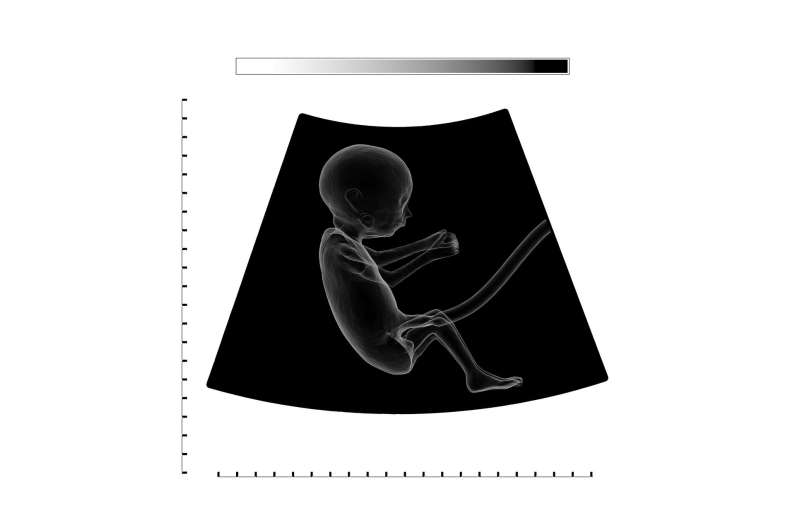Umbilical cord milking may be linked to higher risk of brain bleeding in preterm infants

Milking the umbilical cord—gently squeezing the cord and pushing the contents into the newborn's abdomen before clamping the cord—could increase the risk for severe intraventricular hemorrhage, or bleeding into the brain's fluid-filled cavities, in extremely preterm infants, according to results of a study funded by the National Institutes of Health that was halted for safety concerns.
The study, led by Anup Katheria, M.D., of the Sharp Mary Birch Hospital for Women and Newborns in San Diego and colleagues at institutions in the United States and Europe, had sought to determine if cord milking was an alternative to delayed cord clamping. Unlike cord milking, a delay in clamping allows time for the blood to flow naturally from the cord into the abdomen before clamping and cutting the cord.
After extremely preterm infants (23 to 27 weeks gestation) in the cord milking group were found to have more hemorrhages inside the ventricles, compared to the earliest preterm infants in the delayed clamping group, the study was stopped before enough infants could be enrolled to allow for a statistically valid analysis.
Some studies of term infants have found that delayed cord clamping reduces the chances of anemia and appears to benefit cognitive development in early childhood. In preterm infants, however, the extra time needed for delayed cord clamping also may delay the start of the respiratory support often needed for the infants' underdeveloped lungs.
"Although it's not possible to draw definitive conclusions, the results suggest extreme caution in performing cord milking in this vulnerable group of infants," said Caroline Signore, M.D., of NIH's Eunice Kennedy Shriver National Institute of Child Health and Human Development, who oversaw the study.
An earlier study comparing umbilical cord milking to delayed cord clamping in preterm infants delivered by cesarean suggested that cord milking resulted in higher blood flow and benefits in cognitive development by 2 years of age. A meta-analysis of studies dating back to the 1940s found that preterm infants who underwent cord milking had evidence of higher blood volume, lower risk of bleeding into the ventricles, and a lower likelihood of requiring oxygen therapy. The authors were unaware of any previous studies demonstrating harm from umbilical cord milking.
In the current study, appearing in the Journal of the American Medical Association, the researchers enrolled women at less than 32 weeks of pregnancy at risk for preterm birth. When the women went into early labor, their infants were assigned at random to umbilical cord milking or delayed cord clamping for 60 seconds. For safety reasons, obstetricians could opt out of either procedure and immediately clamp the cord.
Researchers planned to enroll 1,500 infants, with 750 assigned at random to each group. Before the study was halted, 474 infants were randomized, with 236 assigned to cord milking and 238 assigned to delayed clamping.
The study authors classified the results into a single combined outcome: death or severe intraventricular hemorrhage. Among the cord milking group, 29 infants (12%) died or developed severe intraventricular hemorrhaging, compared to 20 infants (8%) in the delayed clamping group, a difference that was not statistically significant.
When the authors considered only the death rate, it also did not differ significantly between the two groups: 7% in the cord milking group vs. 8% in the delayed clamping group.
However, the rate of severe intraventricular hemorrhage was significantly higher in the cord milking group: 8% (20 infants), compared to 3% (8 infants) in the delayed clamping group. Among those in the cord milking group, all 20 with intraventricular hemorrhage were the youngest preterm infants, born in weeks 23 to 27 of pregnancy, compared to 5 of the 8 infants in the delayed clamping group. Among infants born at 28 to 32 weeks, no intraventricular hemorrhage occurred in the cord milking group, and three cases occurred in the delayed clamping group, a rate that did not differ significantly.
Compared to more mature preterm infants, extremely preterm infants' circulatory systems have difficulty regulating blood flow in the brain. The authors theorize that the increase in blood flow resulting from cord milking could have stressed the blood vessels in their brains, making them more likely to rupture. The authors noted that previous studies have shown a higher rate of severe intraventricular hemorrhage in preterm infants delivered vaginally, compared to those delivered by cesarean.
Because the higher risk of intraventricular hemorrhage was found only in extremely preterm infants, the authors are continuing to compare cord milking to delayed clamping in preterm infants born at 30 to 32 weeks and will evaluate development of the two groups at 2 years of age.
More information: Katheria, A, et al Association of umbilical cord milking vs delayed umbilical cord clamping with death or severe intraventricular hemorrhage among preterm infants. Journal of the American Medical Association. 2019.


















